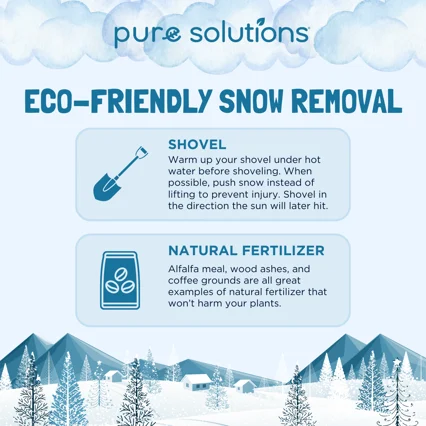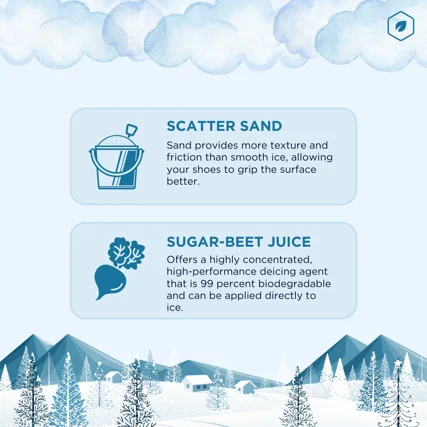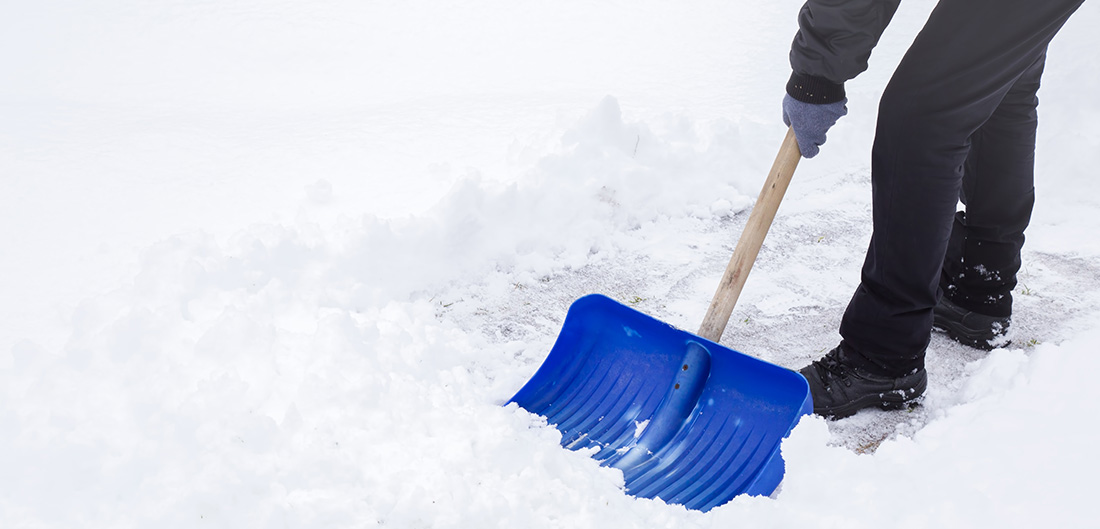Clearing snow isn’t just about convenience –it’s essential for preventing falls, safeguarding property, and ensuring vital access to roads, emergency services, and daily routines. Let’s keep ourselves and our communities safe this winter!


Apply Eco-Friendly Ice Melt Before Snow Falls
Applying ice melt before the snow falls can be an effective and eco-friendly strategy for preventing ice buildup and keeping your walkways and driveways safe. Pre-treating with ice melt creates a proactive barrier.
The ice melt will mix with the falling snow, lowering its freezing point and preventing it from bonding to the surface. The pre-loosened snow is lighter and fluffier, making it easier to shovel or plow before it packs down and turns into a heavy, icy mass.
Eco-Friendly Options
- Sugar-Beet Juice: Offers a highly concentrated, high-performance deicing agent that is 99 percent biodegradable and can be applied directly to ice.
- Calcium Magnesium Acetate: A study published in the Journal of Policy Analysis and Management found that CMA is an effective and environmentally harmless salt substitute.
- Natural Fertilizer: Alfalfa meal, wood ashes, and coffee grounds. Alfalfa meal is a great non-chemical fertilizer that won’t burn your plants. Wood ash from your fireplace contains potassium salts that help melt ice. Ash also absorbs solar energy, increasing the temperature to melt the ice.
Scatter Sand or Cat Litter on Icy Patches
Scattering sand or cat litter on icy patches can be an effective way to gain additional traction and prevent falls. They provide more texture and friction than smooth ice, allowing your shoes to grip the surface better. This is especially helpful for footwear with poor traction, like boots with worn soles.
Sand and cat litter are generally considered more environmentally friendly than some ice melt products, which can harm plants and pollute waterways. However, opting for non-clumping clay litter is best, as clumping varieties can contain harsh chemicals and absorb excessive moisture, leading to unwanted clumping on surfaces.
Some Cool Tricks!
- Spray your shovel: Coat your shovel blade with a silicone spray to prevent snow from sticking.
- Warm up your shovel: Briefly run your shovel blade under hot water to melt any stubborn snow buildup.
- Invest in a scraper: Use a roof ice scraper to prevent icicles from forming on your gutters and eaves.
- Push, not lift: When possible, push snow instead of lifting. It saves energy and reduces back strain. Think snow plow, not weightlifter!
- Use the sun: Shovel in the direction the sun will later hit. Let the sun do some melting for you while you take a break.

Remove Snow to Protect Your Lawn
Deep snow cover creates ideal conditions for snow mold and other fungal diseases that thrive in moist, cool environments. Removing snow allows for better air circulation and sun exposure, hindering fungal growth and protecting your grass.
Repeated snowfall and freezing temperatures can compact the soil beneath the snow, making it difficult for water and air to penetrate. Clearing snow prevents this, allowing root systems to access crucial resources and promoting healthy growth.
Have any more questions? Get in touch with our office team!
Sources:
- Fanelli, Laurie. 3 Road Salt Alternatives That Don’t Harm the Environment, www.tomsofmaine.com/good-matters/thinking-sustainably/3-road-salt-alternatives-that-dont-harm-the-environment. Accessed 12 Feb. 2024
- “Rules on Clearing Snow.” City of Boston, 8 Dec. 2021, www.boston.gov/departments/311/rules-clearing-snow
